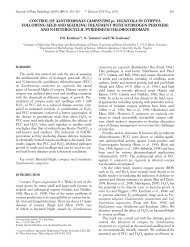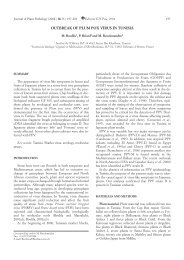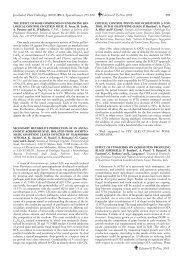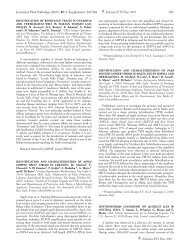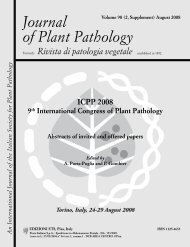Journal of Plant Pathology (2010), 92 (4, Supplement ... - Sipav.org
Journal of Plant Pathology (2010), 92 (4, Supplement ... - Sipav.org
Journal of Plant Pathology (2010), 92 (4, Supplement ... - Sipav.org
Create successful ePaper yourself
Turn your PDF publications into a flip-book with our unique Google optimized e-Paper software.
<strong>Journal</strong> <strong>of</strong> <strong>Plant</strong> <strong>Pathology</strong> (<strong>2010</strong>), <strong>92</strong> (4, <strong>Supplement</strong>), S4.71-S4.105 S4.83<br />
nist, e.g. Trichoderma or P. fluorescens, has been previously investigated<br />
by using functional genomics and proteomic techniques.<br />
In this study we propose testing the contemporary presence <strong>of</strong><br />
both BCAs in a very complex four-player system. The main strategy<br />
<strong>of</strong> this research was to use a proteomic approach in order to<br />
determine which molecular factors are activated in the interactions,<br />
identify those compounds that have an important affect on<br />
the activity <strong>of</strong> either or both BCAs during their concurrent interaction<br />
with tomato roots and/or pathogen, and the relative plant<br />
molecular responses to the different micro<strong>org</strong>anisms. A method<br />
has been developed and optimized to obtain 2-D gel maps <strong>of</strong> separately<br />
collected proteomes from each partner, as well as all the<br />
possible combinations <strong>of</strong> the components. Several plant and microbial<br />
differentially accumulated proteins, selected from the<br />
four interacting proteomes, have been isolated and are being<br />
identified and characterized.<br />
FIRST OBSERVATIONS ON THE FUNGAL ENDOPHYT-<br />
IC COMMUNITY OF OLEA EUROPAEA IN SICILY. V. Ferraro,<br />
S. Lo Piccolo, G. Conigliaro, V. Mondello, L. Torta, S. Burruano.<br />
Dipartimento di Scienze Entomologiche, Fitopatologiche,<br />
Microbiologiche, Agrarie e Zootecniche, Università degli Studi,<br />
Viale delle Scienze 2, 90128 Palermo, Italy. E-mail: santella@unipa.it<br />
During an etiological and epidemiological study on a new decline<br />
(foliar chlorosis and withering twigs) <strong>of</strong> Olea europaea in<br />
Sicily, the composition <strong>of</strong> the endophytic community <strong>of</strong> symptomless<br />
and symptomatic olive tree <strong>org</strong>ans was investigated. Two<br />
Sicilian olive-groves, located in a hill and in a plain, respectively,<br />
comparable for plant age, cultivar and agricultural management,<br />
were taken into consideration from spring 2007 to autumn 2008.<br />
Samples from healthy and diseased leaves and twigs were collected<br />
to isolate fungal endophytes. The fungal endophytic community<br />
varied quantitatively and qualitatively in relation to (i) type<br />
and health condition <strong>of</strong> the sampled <strong>org</strong>an; (ii) site <strong>of</strong> collection<br />
and (iii) survey period. Fungi belonging to the genera Alternaria,<br />
Aureobasidium, Camarosporium, Cladosporium, Diplodia, Phoma,<br />
Pleospora Septoria, Stemphylium, and several Mycelia sterilia were<br />
detected in almost all samples. The overall colonization rates<br />
(CR) were always higher in leaves than twigs, in both localities.<br />
Moreover, CR showed variability also in relation to the health<br />
condition <strong>of</strong> the <strong>org</strong>ans. In fact, both in the hill and the plain, the<br />
endophytic colonization was higher in symptomatic <strong>org</strong>ans than<br />
in the healthy ones. Although many taxa were detected, the results<br />
<strong>of</strong> this investigation suggest that the relatively stable endophytic<br />
fungal community residing in O. europaea is characterized<br />
by a constant composition <strong>of</strong> common taxa. Studies to achieve<br />
fungal identification and to evaluate the role <strong>of</strong> fungal endophytes<br />
in O. europaea are in progress.<br />
CHARACTERIZATION OF PSEUDOMONAS spp. STRAINS,<br />
CAUSAL AGENTS OF CANKERS AND WILT OF STONE<br />
FRUITS IN SARDINIA. M. Fiori, V. Ligios, A. Schiaffino. Dipartimento<br />
di Protezione delle Piante, Università degli Studi, Via E. De<br />
Nicola, 07100 Sassari, Italy. E-mail: fiorim@uniss.it<br />
A collection <strong>of</strong> 94 bacterial strains was obtained from apricot,<br />
nectarine, peach and plum trees showing cankers on twigs, stems<br />
and branches, gum exudates, bud necrosis, wilting <strong>of</strong> shoots, and<br />
spots on the leaves. Thirteen strains, selected on the basis <strong>of</strong> morphology<br />
on NSA and hypersensitivity reaction on tobacco leaves,<br />
were able to infect cherry plum GF31, watermelon and vegetable<br />
marrow plantlets; two strains infected pepper and tomato and<br />
five lilac and lemon fruits. On the basis <strong>of</strong> the results obtained by<br />
Gram reaction, catalase, poly-hydroxybutyrate, fluorescence on<br />
KB and LOPAT tests, five strains were identified as Pseudomonas<br />
syringae (Ps), three as P. viridiflava (Pv), four as P. fluorescens.<br />
One isolate was not identified. Biolog and serological agglutination<br />
tests partially confirmed the above reported results, allowing<br />
the assignment <strong>of</strong> three strains <strong>of</strong> Pseudomonas syringae to the patovar<br />
syringae (Pss). Ater fatty acid analysis on five isolates, one<br />
was ascribed to Ps (S.I., 0.967), one to Pv (S.I., 0.979), one to P.<br />
putida (S.I., 0.847), while two were not identified. The analysis <strong>of</strong><br />
the thirteen strains with BOX-PCR produced 5 reaction pr<strong>of</strong>iles.<br />
One <strong>of</strong> them was characteristic <strong>of</strong> the type strain Pss CFBP 700.<br />
SyrB gene amplification <strong>of</strong> the three Pss strains produced the specific<br />
band <strong>of</strong> 752 bp like the type strain Pss CFBP 700, confirming<br />
their identification. In conclusion, while Pss is already present<br />
in Italy in all plant species analyzed, Pv was not yet reported in<br />
Europe on apricots and nectarine.<br />
EFFECT OF WATER ACTIVITY AND FUNGICIDES ON<br />
COMPETING ABILITIES OF COMMON MAIZE FUNGI.<br />
S. Formenti 1 , N. Magan 2 , A. Pietri 3 , P. Battilani 1 . 1 Institute <strong>of</strong><br />
Entomology and <strong>Plant</strong> <strong>Pathology</strong>, Università Cattolica del Sacro<br />
Cuore, Via Emilia Parmense 84, 29122 Piacenza, Italy. 2 Cranfield<br />
Health, Vincent Building, Cranfield University, Bedford MK43<br />
0AL, UK. 3 Institute <strong>of</strong> Science <strong>of</strong> Food and Nutrition, Università<br />
Cattolica del Sacro Cuore, Via Emilia Parmense 84, 29122 Piacenza,<br />
Italy. E-mail: paola.battilani@unicatt.it<br />
Maize is colonised by a mixture <strong>of</strong> spoilage fungi in pre- and<br />
post-harvest. The occurrence <strong>of</strong> certain dominant fungal species<br />
depends on several abiotic and biotic factors that determine their<br />
prevalence in the maize grain ecosystem. In order to understand<br />
when Fusarium spp. are able to dominate the maize ecosystem, it<br />
is necessary to clarify the complex interactions which occur between<br />
abiotic and biotic factors and their impact on the growth<br />
and between fungal interactions. The aims <strong>of</strong> this study were: (i)<br />
to determine the competitiveness <strong>of</strong> F. verticillioides against a<br />
range <strong>of</strong> fungi commonly growing on maize (F. proliferatum, A.<br />
flavus, A. ochraceus, A. niger and P. verrucosum), on artificial media<br />
under different a w levels (0.99; 0.98; 0.95); (ii) to establish<br />
how the presence <strong>of</strong> sub-optimal concentrations (50% effective<br />
dose) <strong>of</strong> commercial fungicides (tebuconazole, prothioconazole<br />
and prochloraz) affects interspecific interactions. The results<br />
showed how F. verticillioides was able to compete effectively in<br />
dual culture with other fungal species commonly isolated from<br />
maize, although the dominance against some species was modified<br />
by a w and the presence <strong>of</strong> fungicides. The dominance <strong>of</strong> F.<br />
verticillioides without the presence <strong>of</strong> sub-optimal active ingredients<br />
could be mainly due to its ability to grow rapidly and invasively.<br />
A. flavus was the most competitive species at sub-optimal<br />
levels <strong>of</strong> active ingredients tested, which is not surprising because<br />
the tested products are considered as effective mainly towards<br />
Fusaria. However, no important variation in the inter and intraspecific<br />
interaction <strong>of</strong> common fungi in maize was noticed by the<br />
addition <strong>of</strong> fungicides.<br />
ABILITY OF SOME SOIL FUNGI TO DECREASE THE AC-<br />
TIVE PRINCIPLE CONCENTRATION OF BIOFUMIGA-<br />
TION BY BRASSICA CARINATA SEED MEAL. S. Galletti 1 ,<br />
L. Ugolini 1 , P.L. Burzi 1 , S. Cianchetta 1 , R. Roberti 2 , C. Cerato 1 .<br />
1 CRA, Centro di Ricerca per le Colture Industriali, Via di Corticella<br />
133, 40128 Bologna, Italy. 2 Dipartimento di Protezione e Valo-



